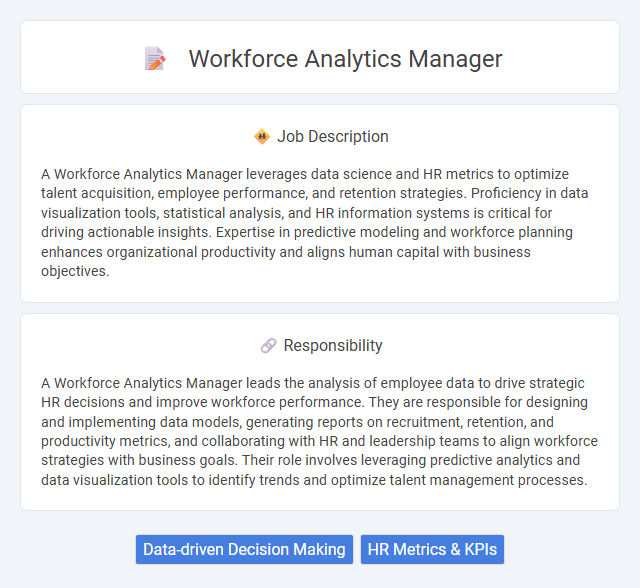
A Workforce Analytics Manager leverages data science and HR metrics to optimize talent acquisition, employee performance, and retention strategies. Proficiency in data visualization tools, statistical analysis, and HR information systems is critical for driving actionable insights. Expertise in predictive modeling and workforce planning enhances organizational productivity and aligns human capital with business objectives.
Candidates with strong analytical skills and a passion for data-driven decision making are likely to thrive as a Workforce Analytics Manager. Individuals who are comfortable interpreting complex workforce patterns and possess excellent communication abilities may be well-suited for this role. Those who prefer routine tasks or lack interest in strategic workforce planning might find the position less compatible with their strengths.
Qualification
A Workforce Analytics Manager requires strong expertise in data analysis, statistical modeling, and workforce planning to drive strategic decision-making. Proficiency in tools like SQL, Python, Tableau, and Excel is essential for managing large datasets and creating actionable insights. Advanced knowledge in HR metrics, predictive analytics, and experience in collaborating with cross-functional teams enhances the ability to optimize talent management and organizational effectiveness.
Responsibility
A Workforce Analytics Manager leads the analysis of employee data to drive strategic HR decisions and improve workforce performance. They are responsible for designing and implementing data models, generating reports on recruitment, retention, and productivity metrics, and collaborating with HR and leadership teams to align workforce strategies with business goals. Their role involves leveraging predictive analytics and data visualization tools to identify trends and optimize talent management processes.
Benefit
Workforce Analytics Managers likely improve organizational efficiency by leveraging data-driven insights to optimize talent management and resource allocation. They probably enhance decision-making processes through predictive analytics, leading to better workforce planning and cost reduction. This role may also increase employee engagement and retention by identifying trends and developing strategic interventions.
Challenge
Workforce Analytics Managers likely face the challenge of interpreting complex data sets to provide actionable insights for strategic decision-making. Balancing accuracy with speed in analysis may pose ongoing difficulties, given the dynamic nature of workforce trends and organizational needs. They probably need to continuously adapt to new analytics tools and methodologies to maintain effective workforce optimization.
Career Advancement
Workforce Analytics Managers leverage data-driven insights to optimize talent management, employee productivity, and organizational performance, making them pivotal in strategic decision-making. Mastery of advanced analytics tools, HR metrics, and predictive modeling enhances their value, opening pathways to senior roles such as HR Director or Chief People Officer. Continuous skill development in big data technologies and business intelligence fosters career growth and leadership opportunities in human capital management.
Key Terms
Data-driven Decision Making
A Workforce Analytics Manager leverages advanced data analytics and business intelligence tools to transform workforce data into actionable insights that drive strategic decision-making. By analyzing employee performance, talent acquisition metrics, and workforce trends, they optimize human capital management and enhance organizational productivity. Their expertise enables leaders to make evidence-based decisions that improve employee engagement, reduce turnover, and align workforce planning with business goals.
HR Metrics & KPIs
Workforce Analytics Managers specialize in leveraging HR metrics and KPIs to drive strategic decision-making and enhance organizational performance. Key responsibilities include analyzing employee turnover rates, productivity levels, and engagement scores to identify trends and inform talent management strategies. Proficiency in data visualization tools and predictive analytics enables these managers to provide actionable insights that optimize recruitment, retention, and workforce planning.
 kuljobs.com
kuljobs.com